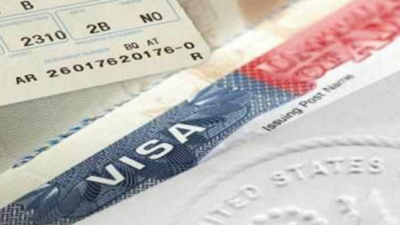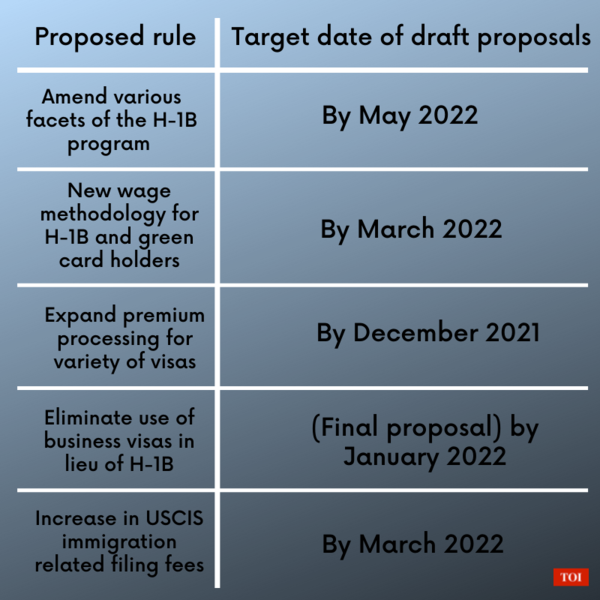- News
- World News
- US News
- Modernisation of H-1B program, expansion of premium processing on Biden’s winter agenda
Trending
This story is from December 14, 2021
Modernisation of H-1B program, expansion of premium processing on Biden’s winter agenda
The Biden administration has published its semi-annual regulatory agenda, whereby various government departments indicate their immediate and long-term action plans.

The Biden administration has published its semi-annual regulatory agenda, whereby various government departments indicate their immediate and long-term action plans.
On the immigration front, many of the proposed plans of action outlined by agencies such as the Department of Homeland Security (DHS), Department of Labour (DOL) and Department of State (DOS) were contained in the spring agenda.The dates of the publication of the draft proposals have been extended. Once the draft proposals are released, it takes several months before a final rule is issued.
Modernisation of the H-1B program: The DHS in the recently rolled out winter agenda, continues to pursue its plan to modernise the H-1B program. Among the proposals is a plan to amend the definition of the employer-employee relationship and provide flexibility for start-up entrepreneurs. It also contains a proposed plan of action to implement new requirements and guidelines for site visits – including in connection with applicants filed by sponsoring employers whose basic business information cannot be validated through commercially available data.
According to immigration experts, site visit guidelines are likely to be strengthened to curb registrations for H-1B beneficiaries by fly-by-night manpower consultancies. The H-1B registration process is also to be bolstered to mitigate misuse and fraud.
 Note: Typically, release of draft proposals is followed by a process that starts with inviting public comments and ends with review of the draft by Office of Management and Budget, followed by its finalisation. The rule making process takes several months.
Note: Typically, release of draft proposals is followed by a process that starts with inviting public comments and ends with review of the draft by Office of Management and Budget, followed by its finalisation. The rule making process takes several months.
It is unclear what a revision in regulations relating to the ‘employer-employee relationship’ could entail. From a plain reading of the proposed course of action, some leeway is expected to enable start-ups to easily hire H-1B workers.
During the Trump regime, IT service companies whose H-1B employees were placed at client sites were weighed under an onerous burden of proof and documentation requirements such as providing detailed customer contracts and itineraries of employees. This led to processing delays and a spike in denial of H-1B visa applications. The policy was set aside by a US court.
For the proposed plan, proper rule-making processing, including inviting and vetting of public comments (including of stakeholders) is expected to be followed.
“DHS also intends to clarify when a material change to H-1B employment occurs, necessitating an amended petition (application). Notification requirements relating to worksite location changes are also expected to be streamlined, explains Mitch Wexler, partner at Fragomen, a global immigration law firm. Proposals relating to H-1B modernisation program were originally slated for publication in December 2021, but have been rescheduled for May 2022.
From the immigration perspective, agenda items announced by the Department of State (DOS) and Department of Labour (DOL) are also important.
Increase H-1B wage rates: A Trump-era proposal to allocate H-1B cap visas based on wages, with priority given to the highest wage earners has been put on the backburner. However, DOL intends to move ahead with a rule to raise the prevailing wage rates for H-1B and green cardholders. One of the action points in US President Joe Biden’s pre-election manifesto was to ‘Curb exploitation of foreign workers, by ensuring that employers cannot hire below the market rate’.
“A final prevailing wage rule had been scheduled to take effect on November 14. However, in June a federal court had vacated the Trump-era regulation, with the DOL’s consent. As expected, DOL is promulgating a new prevailing wage regulation, taking into consideration the feedback it received in a request for public comments conducted this past spring,” explains Wexler.
Expansion of premium processing: Premium processing is set to be expanded to cover various cases. Of particular interest to the Indian diaspora will be that applications to change or extend status for dependents of H-1B, L-I visas will be covered by premium processing, as will processing of employment authorisation documents (EADs). This proposal to expand the premium processing program is in the final stages and is currently under review by the Office of Management and Budget.
Addressing the cap-gap issue for international students: The term cap-gap refers to the period between the time an international student’s F-1 status ends and the H-1B status begins. International students are eligible for a 12-month (three years for STEM students) optional practical training (OPT) under which they can work in the US. In many cases, the organizations where they are undergoing OPT sponsor them for the H-1B work visa. If the H-1B application is filed in time, they can continue working beyond the expiry date on their OPT employment authorization document, while waiting for the start date (October 1) of an approved or pending H-1B application. However, if the application is not processed by October 1, the student must stop working as of this date. Many students have lost out, because of this and the winter agenda reiterates that the cap-gap issue will be addressed.
Other plans of action: Other proposed measures announced in the winter agenda include a proposal by the DOS to eliminate the use of the B-1 business visa category in lieu of H-1B.
From a sponsoring employer’s perspective, the $4000/$4500 border security fee filed by sponsoring employers having a significant number of H-1B and L-1 employees, will also apply to extension of stay and amended applications. Further, overall, USCIS filing fees are expected to increase to enable the US Citizenship and Immigration Services to meet its operational costs. On the flip side, there is a proposal to permit optional alternatives to physical inspection of identity and work authorisation documents in the Form I-9 verification process. “Though the specific alternatives are not yet known, they could include forms of remote document inspection like those temporarily in place due to the Covid-19 pandemic. The proposed regulation is expected to be published in June 2022,” states Wexler.
On the immigration front, many of the proposed plans of action outlined by agencies such as the Department of Homeland Security (DHS), Department of Labour (DOL) and Department of State (DOS) were contained in the spring agenda.The dates of the publication of the draft proposals have been extended. Once the draft proposals are released, it takes several months before a final rule is issued.
Modernisation of the H-1B program: The DHS in the recently rolled out winter agenda, continues to pursue its plan to modernise the H-1B program. Among the proposals is a plan to amend the definition of the employer-employee relationship and provide flexibility for start-up entrepreneurs. It also contains a proposed plan of action to implement new requirements and guidelines for site visits – including in connection with applicants filed by sponsoring employers whose basic business information cannot be validated through commercially available data.
According to immigration experts, site visit guidelines are likely to be strengthened to curb registrations for H-1B beneficiaries by fly-by-night manpower consultancies. The H-1B registration process is also to be bolstered to mitigate misuse and fraud.
Winter agenda: Proposed immigration-related action plan

It is unclear what a revision in regulations relating to the ‘employer-employee relationship’ could entail. From a plain reading of the proposed course of action, some leeway is expected to enable start-ups to easily hire H-1B workers.
During the Trump regime, IT service companies whose H-1B employees were placed at client sites were weighed under an onerous burden of proof and documentation requirements such as providing detailed customer contracts and itineraries of employees. This led to processing delays and a spike in denial of H-1B visa applications. The policy was set aside by a US court.
For the proposed plan, proper rule-making processing, including inviting and vetting of public comments (including of stakeholders) is expected to be followed.
“DHS also intends to clarify when a material change to H-1B employment occurs, necessitating an amended petition (application). Notification requirements relating to worksite location changes are also expected to be streamlined, explains Mitch Wexler, partner at Fragomen, a global immigration law firm. Proposals relating to H-1B modernisation program were originally slated for publication in December 2021, but have been rescheduled for May 2022.
From the immigration perspective, agenda items announced by the Department of State (DOS) and Department of Labour (DOL) are also important.
Increase H-1B wage rates: A Trump-era proposal to allocate H-1B cap visas based on wages, with priority given to the highest wage earners has been put on the backburner. However, DOL intends to move ahead with a rule to raise the prevailing wage rates for H-1B and green cardholders. One of the action points in US President Joe Biden’s pre-election manifesto was to ‘Curb exploitation of foreign workers, by ensuring that employers cannot hire below the market rate’.
“A final prevailing wage rule had been scheduled to take effect on November 14. However, in June a federal court had vacated the Trump-era regulation, with the DOL’s consent. As expected, DOL is promulgating a new prevailing wage regulation, taking into consideration the feedback it received in a request for public comments conducted this past spring,” explains Wexler.
Expansion of premium processing: Premium processing is set to be expanded to cover various cases. Of particular interest to the Indian diaspora will be that applications to change or extend status for dependents of H-1B, L-I visas will be covered by premium processing, as will processing of employment authorisation documents (EADs). This proposal to expand the premium processing program is in the final stages and is currently under review by the Office of Management and Budget.
Addressing the cap-gap issue for international students: The term cap-gap refers to the period between the time an international student’s F-1 status ends and the H-1B status begins. International students are eligible for a 12-month (three years for STEM students) optional practical training (OPT) under which they can work in the US. In many cases, the organizations where they are undergoing OPT sponsor them for the H-1B work visa. If the H-1B application is filed in time, they can continue working beyond the expiry date on their OPT employment authorization document, while waiting for the start date (October 1) of an approved or pending H-1B application. However, if the application is not processed by October 1, the student must stop working as of this date. Many students have lost out, because of this and the winter agenda reiterates that the cap-gap issue will be addressed.
Other plans of action: Other proposed measures announced in the winter agenda include a proposal by the DOS to eliminate the use of the B-1 business visa category in lieu of H-1B.
From a sponsoring employer’s perspective, the $4000/$4500 border security fee filed by sponsoring employers having a significant number of H-1B and L-1 employees, will also apply to extension of stay and amended applications. Further, overall, USCIS filing fees are expected to increase to enable the US Citizenship and Immigration Services to meet its operational costs. On the flip side, there is a proposal to permit optional alternatives to physical inspection of identity and work authorisation documents in the Form I-9 verification process. “Though the specific alternatives are not yet known, they could include forms of remote document inspection like those temporarily in place due to the Covid-19 pandemic. The proposed regulation is expected to be published in June 2022,” states Wexler.
End of Article
FOLLOW US ON SOCIAL MEDIA










